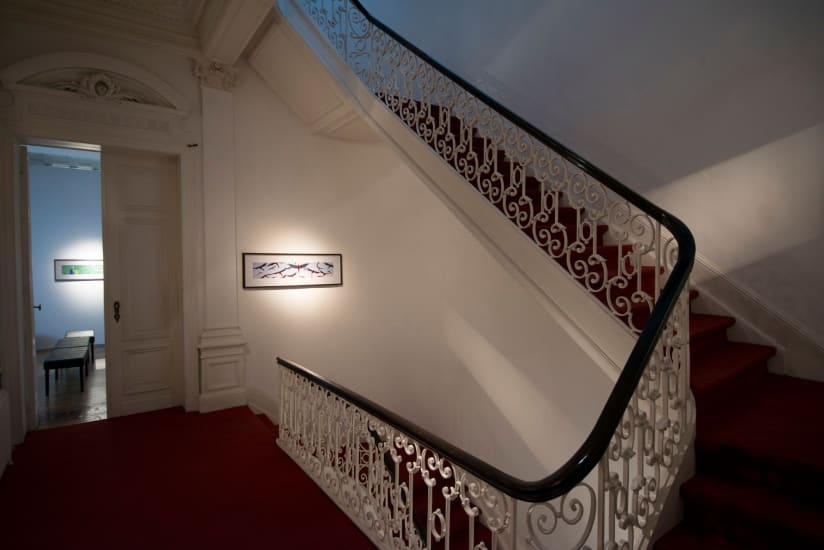
AES+F 'The Trilogy Plus'
11 September - 7 November 2015
Aeroplastics @ Rue Blanche Str., Brussels
Aeroplastics contemporary / Jerome Jacobs present the first exhibition in Belgium of the Russian collective AES+F, composed of artists Tatiana ARZAMASOVA, Lev EVZOVICH, Evgeny SVYATSKY and Vladimir FRIDKES.
Since the mid-1990s the group has developed a powerful and original study concerning the status of the image, both fixed and animated – something that gives each of their projects a truly unique dimension. While today's video art oscillates between cinematographic heritage (Steve McQueen) and the future of the You Tube generation (Ryan Trecartin), AES+F explores their own quite particular path, within an aesthetic that allies the monumental and the intimist.
The exhibition focuses on the group's most emblematic project, Trilogy, whose making took nearly a decade to achieve. The three works that go to make it up are Last Riot (presented in the Russian Pavilion at the 2007 Venice Biennale), The Feast of Trimalchio (unveiled, again in Venice, in 2009), and Allegoria Sacra (presented in 2011 at the Multimedia Museum of Moscow, and in parallel at the Biennial of Contemporary Art). These are multimedia works, combining still- and moving images, photographs and digital animation, and within which music often plays a preponderant role.
Each section of this vast triptych addresses, in a most singular style, one of the three myths upon which Christian faith reposes: Heaven, Hell and Purgatory. The parallel with the Old Masters does not stop there: Allegoria Sacra draws direct inspiration from the eponymous painting by Giovanni Bellini (1430-1516), while Gareth Harris recalls - besides the Mannerist aesthetic that characterizes the approach of AES+F – an encounter between Calvin Klein (b. 1942) and Caravaggio (1571-1610), regarding Trimalchio. These references owe nothing to mere chance: Bellini, who incarnates the transition from the Gothic to the Renaissance in the history of painting, symbolizes the start of a new era, one more focused on the recognition of the individual as such. Olga Sviblova aptly notes how the working process of AES+F is taking place, too, at a pivotal moment in history, when the advent of a globalized world and digital networking might lead to humanity's deliverance or to its damnation.
Last Riot portrays androgynous children and adolescents confronting each other in a setting that seems taken from a video game, with all sorts of weapons – machine guns and swords, golf clubs and baseball bats. This orgy of violence is tempered by the total absence of visible wounds or spilled blood. The faces are impassive, and nobody on the battlefield seems to play the role of either victor or victim. And although it comprises a founding section of the trilogy, Last Riot already contains many of the symbolic and iconographic visual elements that AES+F would go on to subsequently further develop.
The Feast of Trimalchio continues in this same ambiguous vein, but this time inspired by a literary source: namely, an episode from the Satyricon portraying a sumptuous feast at the table of a wealthy freedman anxious to impress his guests. The décor is that of a luxury hotel set on a paradisiacal island, combining the allure of mountains and sea. Masters and servants, from all five continents, are engaged in a strange ballet played out to the accompaniment of Beethoven's Seventh Symphony – but just who is at the service of whom? Last Riot develops a reflection upon the hypothetical innocence of childhood exposed to the violence of today's world, while Trimalchio formulates an acerbic critique on the emergence of a wealthy class that's on the point of losing all contact with the real world – a situation no stranger to the Russia of the first years of this century.
The last section of the trilogy, Allegoria Sacra, is also the most complex, weaving together multiple locations, protagonists and references, in a vast fresco where Giovanni Bellini meets up with 2001: A Space Odyssey. The main setting is that of an airport in which the characters from all backgrounds and beliefs are having to share their wait, like this black priest dozing beside a white skinhead armed with a bat. After Hell and Heaven, here AES+F offers us their own quite personal vision of Purgatory...
Fruit of a long-term process – the taking of countless shots that serve as starting-points for their animations – the works of AES+F impress us as much by their ambition as by their technical perfection. But beyond the aesthetic shock that they produce, these images relay a discourse (at once ironical and critical) on the tensions that reign in our society of today. In this, and although perfectly embedded in the digital world, AES + F joins the tradition of the great Old Masters who, under cover of allegorical or biblical evocations, produced compositions bristling with allusions to the 'way of the world' in which they lived.
P-Y Desaive, Brussels 2015

